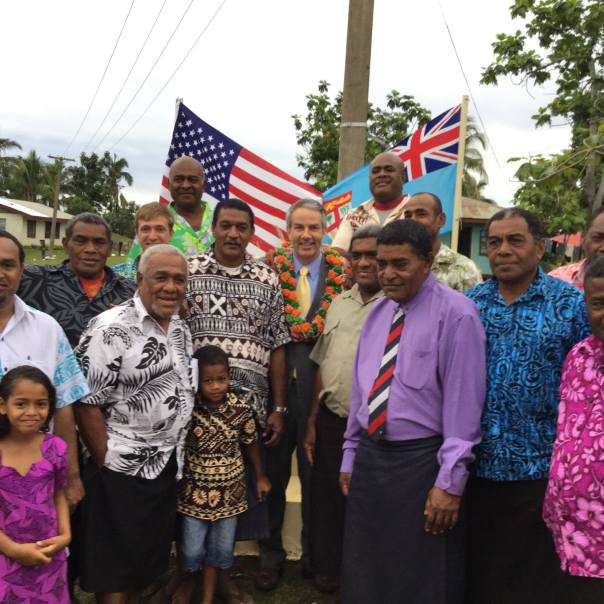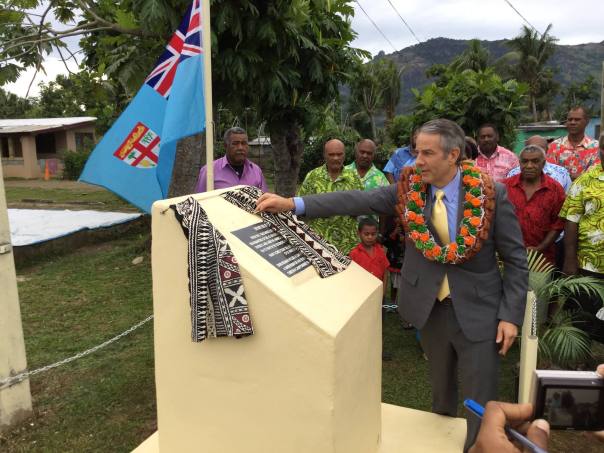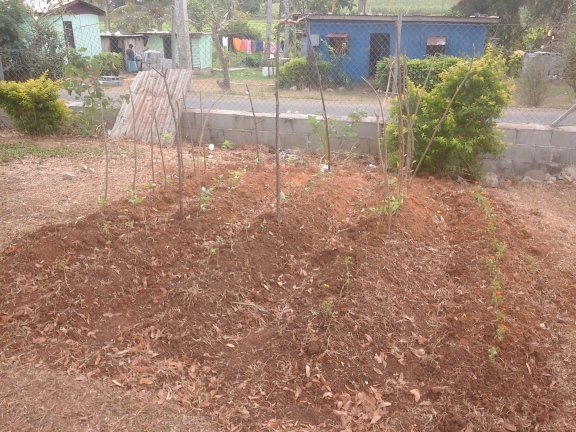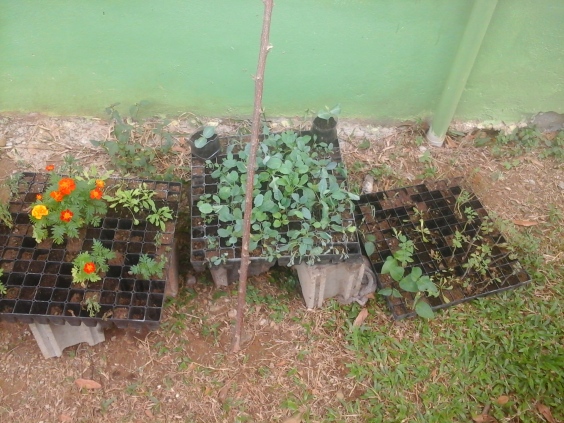This was not a particularly exceptional or unique day, neither a real upper nor a downer, but it was pretty busy, and so it is perhaps a good example of a day to convey what kind of things I get up to on the regular.
Woke up this morning, planning on having French toast for breakfast, but my last two eggs had both gone off. So instead I made a grilled pb & j and a cup of coffee, breaking my fast as I caught up on news. Took a quick bucket bath, threw on my pocket sulu and button-down just in time for the Monday morning assembly. Get outside, we do the greetings – each teacher bellows out a morning greeting in their chosen language and the children synchronize a response – and we have the usual church songs and flag parade. Religion and nationalism, just what the doctor ordered.
Then I went to check up with a student of mine who I’m helping prepare for an oratory contest. She hadn’t brought it to school, no problem, try to find a kid in a younger class for a separate age-grouping of oratory contests. And the photocopy for the topic has gone missing, so there is the requisite asking of each teacher before finding a copy, and then I wrote out the speech for the class 6 kid. Typically, teachers write the speeches, so I compromised, having Vere of class eight write her own while I wrote the one for class six.
Next, into the village, to meet with the Turaga ni Koro[1] and Mata ni Tikina[2] about starting on the US history memorial project. We have all the materials and have had them for a good two weeks now, yet everyday they say “we’ll start tomorrow”. So I go and surprise surprise, they are going off to a meeting and we will be starting tomorrow.
So I go back to the school and catch up with Don, talk about how best to approach Master Meli, a trusted local expert on Sabeto, to help us edit and write a historical introduction to the dictionary. Send a text to M Meli, find a phone number for one of our elder editors who took a few copies, call him, he’ll be coming later.
Back to the school, I’ve got a half-hour til lunch, perfect for a computer class, so I grab the most bored-looking class (today, Class Seven) and do a quick computer class with them. This typically is Microsoft Word – knowing how to do basic things like underline, bold, select things, save etc. Then the kids that finish quick can do Mavis Beacon, an old school but good typing program.
Lunch mada. No onions, so I got into the village, buy some onions, get back, realize I have no eggs, so I just ate a cucumber and made a grilled cheese and tomato sandwich.[3] Kana,[4] read a bit, get the call from Peace Corps staff to meet them on the roadside on the way to a potential site up the road. Go out there, and as I’m waiting for the bus a young Indian woman starts talking to me.[5] She is not quite flirtatious, but she is married, so I’m quite surprised because there are other Indians around who would likely tell her husband about this encounter. It turns out she grew up in Lautoka and only married here, which makes sense. Not the first time an urban transplanted married woman has struck up eager conversation with me, likely seeing my whiteness/Westernness as a haven from her rural conservative surroundings.[6]
Staff come, we go to the site. Nothing interesting, the Principal says he wants a person, I think it’s a meh, alright situation. We go to the nearby village to find a place, but the TK isn’t around. So they take me home and we arrange to meet tomorrow. It’s already three, and I need to go the farm and get cabbage I promised people and also go shopping.
At my place there is Ilisoni Galala, my elder editor, waiting for me, and he goes over a few words I’ve missed, though he hasn’t actually edited what we’ve done. And he tells me he’s dropped off two and will drop off two more sheaths of translations. Set, thanks. Change quickly, water my newly planted beans and marigolds, move to the farm.
At the farm, Chodhtu gives me a plastic (bag) of cabbage from his own farm. Not what I came for, but welcome nonetheless. When I go to Janet and Semis place[7] I talk to Kula, and we check out the cabbage. It’s been sprayed this morning, no good, so I just grab some cucumbers. On the way back I water my tomato seedlings in Livai’s nursery, which aren’t looking great. Need to transplant those pronto.
Get back, drop things, grab wallet, head for the bridge. On the way I see my Yaca, the one dating Nita Lu, and give him the cabbage and cucumbers to take to their house. Then I see a kid throwing a rock for no good reason so I pick him up and threaten to throw him in the village. These are the rare moments of physical contact I have to sneak in to stave off psychopathy – picking up and kissing kids (everyone does it, you’re weird if you don’t) and pulling Don or Seru into the occasional hug. Get on the bus, lako sara I Namaka.[8]
In Namaka, go to the ATM, then the market because it’s getting a bit late (past five) and they start closing then. Get some tomatoes, lettuce, two little apples, cilantro and carrots. Go to the supermarket, get onions (85 cents for five, as compared to a dollar for two in the village – fucks going on), jam, cheap linguine. Finally, bread and a coke. Back on the bus.
Get here, Vere has her speech, I type it up. Plenty grammatical errors, which mostly confirms my perspective on English vs. Fijian, that the propositions are so fundamentally different they make Latin languages all look like the same language. She is one of the sharpest in the class, but she still makes basic mistakes like “we are so asleep for the safety of our environment” and “the other one has badly effect from the human activities”. There is no Fijian[9] translation of “for”, there is no common way in Fijian to say “effect”, nonetheless any distinction from “effected”. Tenses in Sabeto are mostly reflected in pronouns – muru (present) vs. miri (future), never really touching the verb.
And then I mix the coke with some duty-free rum and write this blog post.
Dinner time. Spaghetti ro,[10] thanks be to those farmers that replanted tomatoes after Cyclone Winston and whatever market forces are responsible for such cheap linguine in Rajendras supermarket in Namaka.[11]
[1] Village headman, but literally Man of the Village in Bauan (we would say Momo ni Rara but hey, colonialism and Bauanization).
[2] District Representative, also a carpenter
[3] Cheese I brought back from the US, tomatoes are finally getting cheap again in the market.
[4] eat
[5] This is noteworthy because in Fiji, especially in rural areas, young women very rarely approach young men they don’t know. And then I remember how much I miss Knox, and liberal America in general.
[6] Forgive my pontificating.
[7] Janet and Semi Lotawa, an American-Fijian couple that run Rise Beyond the Reef, a very cool couple.
[8] Go to Namaka.
[9] When I say Fijian I mean the national dialect Bauan and TatavaSabeto. I cannot account for the other 200+ dialects.
[10] “ro” is our equivalent of “mada”, meaning a soft command, or a thing I am about to do.
[11] A packet for 3.50 FJD, less than 2 USD



